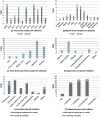Drowning and Nonfatal Drowning in Children and Adolescents: A Subsequent Retrospective Data Analysis
- PMID: 38671656
- PMCID: PMC11049416
- DOI: 10.3390/children11040439
Drowning and Nonfatal Drowning in Children and Adolescents: A Subsequent Retrospective Data Analysis
Abstract
Fatal and nonfatal drowning are among the leading causes of death and lifelong severe neurological impairment among children and adolescents. This study aimed to complement research from Leipzig 1994-2008 to seek trends within risk factors, treatments, and outcomes throughout the last decade. We retrospectively investigated data of 47 inpatients aged 0-18 admitted to Leipzig University Department of Pediatrics who matched ICD-10 code T75.1 from 2008 to 2020 and compared them to a preceding study at the same institution. We also examined the prognostic value of parameters regarding the patients' outcomes. There were three median incidents per annum. The median age was 2.75 years; 76% of incidents happened in males. An accumulation was seen during the summer months and weekends. Most drowning incidents occurred in private ponds or pools (48.9%). Thirty-nine children were discharged without resulting morbidity, four showed neurological impairment, and three died. Risk factors concerning age, sex, and incident characteristics were confirmed. Special supervision needs still apply to 1-3-year-old male children or children with pre-existing health conditions around private pools and ponds. Hospitalization duration shortened, and morbidity and lethality decreased since the previous study. There was structural improvement in primary care and medical documentation. Parameters suggesting good outcomes include a submersion time < 5 min, GCS > 3 points, spontaneous movement upon admission, remaining pupillary light response, the absence of cardiovascular arrest, body temperature ≥ 32 °C, pH > 7, blood glucose < 15 mmol/L, lactate < 14 mmol/L, base excess ≥ -15 mmol/L, and the absence of ARDS. Clear legislation can contribute to improved private home water safety. Further studies should include a broad in- and outpatient spectrum and standardized incident documentation presupposing Utstein-style reporting. Regular reinvestigation of consistent geographical regions facilitates process evaluations of drowning epidemiology and therapy evolution.
Keywords: children and adolescents; drowning prevention; neurological outcomes; prognostic factors; submersion.
Conflict of interest statement
The authors declare no conflicts of interest.
Figures
Similar articles
-
[Retrospective analysis of 44 childhood drowning accidents].Wien Klin Wochenschr. 2010 Jul;122(13-14):405-12. doi: 10.1007/s00508-010-1400-7. Epub 2010 Jul 8. Wien Klin Wochenschr. 2010. PMID: 20602279 German.
-
Drowning in Children: Retrospective Analysis of Incident Characteristics, Predicting Parameters, and Long-Term Outcome.Children (Basel). 2020 Jul 1;7(7):70. doi: 10.3390/children7070070. Children (Basel). 2020. PMID: 32630249 Free PMC article.
-
Epidemiology of Drowning Incidents among Children at Sultan Qaboos University Hospital Oman.Oman Med J. 2021 Nov 30;36(6):e320. doi: 10.5001/omj.2021.104. eCollection 2021 Nov. Oman Med J. 2021. PMID: 34868666 Free PMC article.
-
Day care as a strategy for drowning prevention in children under 6 years of age in low- and middle-income countries.Cochrane Database Syst Rev. 2021 Apr 22;4(4):CD014955. doi: 10.1002/14651858.CD014955. Cochrane Database Syst Rev. 2021. PMID: 33884613 Free PMC article.
-
Pediatric near-drowning and drowning.Saudi Med J. 2013 Feb;34(2):119-22. Saudi Med J. 2013. PMID: 23396456 Review.
References
-
- World Health Organization, editor. Global Report on Drowning: Preventing a Leading Killer. World Health Organization; Geneva, Switzerland: 2014.
-
- DLRG Bundesverband Todesfälle Nach Altersgruppen. [(accessed on 14 December 2022)]. Available online: https://www.dlrg.de/informieren/die-dlrg/presse/statistik-ertrinken/
-
- Bundesarbeitsgemeinschaft Mehr Sicherheit Für Kinder e. V. Häufigste Unfallarten Mit Todesfolge. [(accessed on 14 December 2022)]. Available online: https://www.kindersicherheit.de/fachinformationen/unfallstatistiken.html.
-
- Peden M. World Health Organization World Report on Child Injury Prevention. World Health Organization; Geneva, Switzerland: 2008. pp. 59–77. - PubMed
LinkOut - more resources
Full Text Sources





